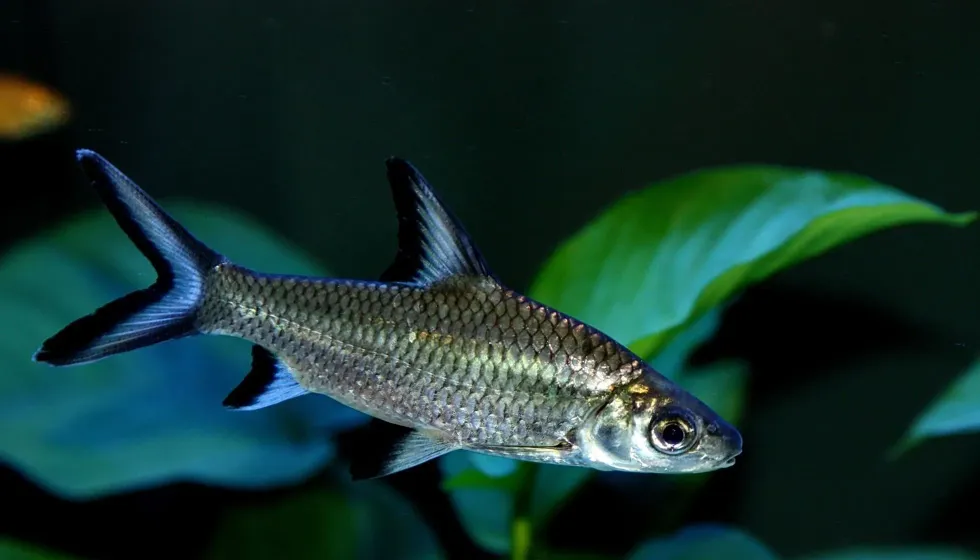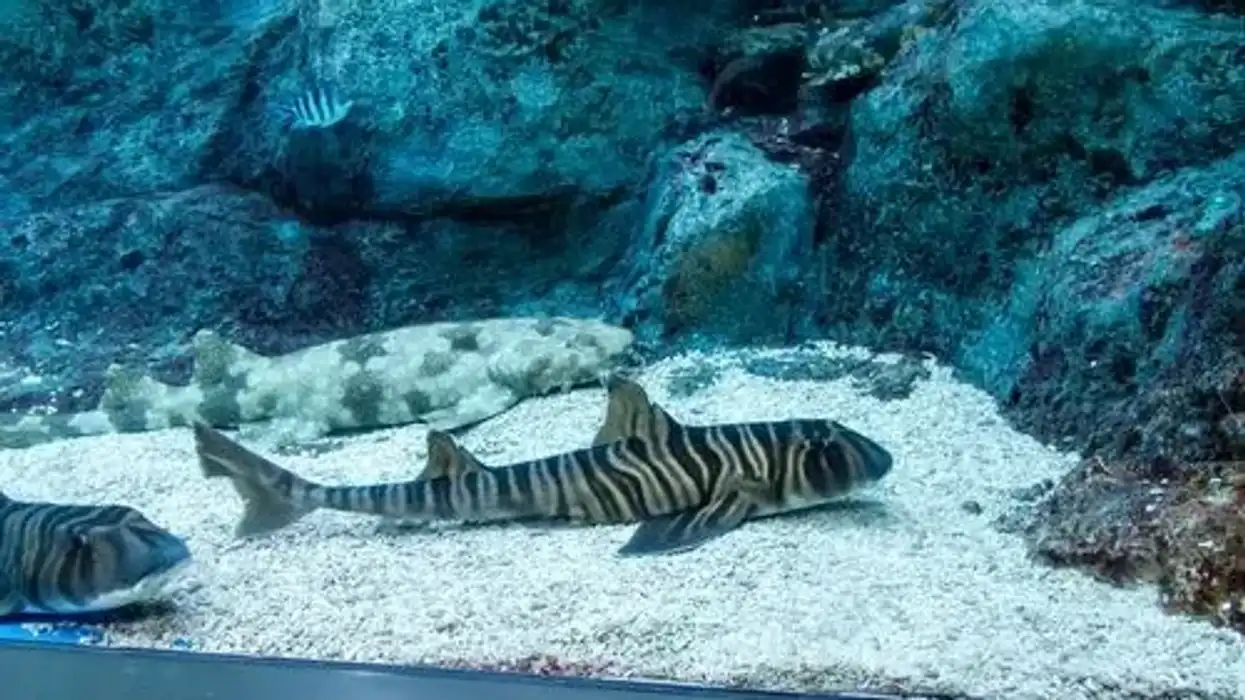The bala shark (Balantiocheilus melanopterus) is a species of large freshwater fish from Southeast Asia. Fish enthusiasts consider this fish species at some point or another for their fish tank.
Having tremendously cool bodies and temperament, the peaceful nature of this active fish attracts a lot of owners to keep this huge bala shark in their homes. There are various different names given to this species such as the tricolor shark, silver bala, silver shark, tricolor shark minnow, and shark minnow.
The biggest bala shark is seen in the wild, and not in a community tank as the fish do not reach their full potential in an enclosure. The bala shark max size ever seen is 14 in (35.56 cm).
This fish has a peaceful temperament and likes to live in a small school. To accommodate more of the full-grown bala shark species, a large aquarium tank size 150 gal tank (567.8 L) should be used.
All water conditions like water hardness, temperature, and a good filtration system should be maintained in the aquarium.
Bala shark tankmates can include a lot of different fish species, but one should avoid small fish as they may end up being bala shark food! However, this fish may get along with most other species in a home aquarium.
For more relatable content, check out these horn shark facts and reef shark interesting facts.
Bala Shark Interesting Facts
What type of animal is a bala shark?
The bala shark fish is a species of freshwater fish in the family Cyprinidae. However, as the name suggests, they are not true sharks.
What class of animal does a bala shark belong to?
The bala shark belongs to the class of Actinopterygii in the kingdom of Animalia.
How many bala sharks are there in the world?
The population of the freshwater bala shark is not known. The area where the community of this fish is found is restricted to 247 sq mi (640 sq km) in the natural habitat. The population is declining at a faster rate in recent times.
Where does a bala shark live?
This fish is common in the Malay Peninsula, Sumatra, and Borneo. They are found in the fast-flowing rivers of Sumatra, Malaysia, Thailand, Cambodia, and Kalimantan.
What is a bala shark's habitat?
The bala shark fish is found in fast-flowing rivers and streams of Southeast Asia. This fish is found in midwater depths of medium-sized and large lakes and rivers in their habitat.
Apart from that, this fish is kept as a pet in many parts of the world in a community aquarium tank setting.
Who do bala sharks live with?
This fish is known to be non-aggressive with other species of tropical fish. The bala shark fish can be kept in a group of five or more fish. A suitably sized aquarium is needed to give all of the sharks enough room to swim around the tank.
How long does a bala shark live?
The bala shark lifespan is found to be around 10 years in captivity. In the wild, the lifespan is not known.
How do they reproduce?
The required conditions for bala shark breeding are not available which is a possible reason why breeding in captivity is less. Breeding by commercial breeders in Asia uses hormones to induce spawning.
To breed them in a tank, first, the sex needs to be determined. Males are slightly larger and females have a rounder belly.
Sexual maturity is reached after three years. Before they reach puberty, these fish should be kept separated. When they reach the age of sexual maturity, four to five bala sharks should be kept in a tank together comprising both males and females.
Bala shark mating starts with the females laying eggs. Males then fertilize these eggs with milt. Plants and other hiding props should be kept on the side to give more area to swim around.
Parents should be removed after spawning and fertilization. In 24 hours, larvae can be seen and in three to four days, fry is seen.
It has been observed that bala sharks take nine to 12 months to grow from 3-6 in (7.6-15.2) in an aquarium tank. The rate of growth is pretty slow. The adult size is reached after a couple of months.
What is their conservation status?
The conservation status of the bala shark is considered to be Vulnerable by the IUCN Red List. The main reason for this status is the lack of distribution and habitat degradation due to overfishing, pollution, and urbanization.
Vanished from most major river basins from the world, proper care needs to be taken to keep the concern of endangerment at bay for the bala shark.
Bala Shark Fun Facts
What do bala sharks look like?
Bala sharks have a long elongated, torpedo-like body with a large single standing dorsal fin. These sharks have a silver body with their pelvic fins, caudal fin, anal fin, and dorsal fin having black margins. The anal fin is smaller than the ventral fins.
This fish is colored yellow, black, and gray which is how they got the name, tri-color. These beautiful fishes are a sight in an aquarium. They have big eyes to easily catch their prey.
How cute are they?
The gradient body and the scales being close to each other makes light bounce off their body beautifully. This makes the bala shark one of the most popular aquarium fishes to keep.
How do they communicate?
Fishes communicate by sound, smell, motion, and electrical impulses.
How big is a bala shark?
When young, bala shark size only starts from around 3 in (7.6 cm). They can be easily adjusted in a small tank with other species. However, growth is tremendously fast for the bala shark. As a freshwater fish, a bala shark full-grown size is around 14 in (35.56 cm).
The bala shark growth rate is slower in the tank as they only grow up to a length of 12 in (30.4 cm).
How fast can a bala shark swim?
This schooling fish is known to be pretty quick while swimming even though the bala shark full size being bigger than one foot. The exact speed is not known.
How much does a bala shark weigh?
The weight of this species is not known.
A full-size bala shark can outgrow a small bala shark aquarium really fast. Therefore, larger tanks are required to even house a single big bala shark, let alone a school of them.
What are the male and female names of the species?
Male and female bala sharks are not given different names.
What would you call a baby bala shark?
A baby bala shark is called a fry.
What do they eat?
The bala shark diet consists of insects, small crustaceans, larvae, algae, and parts of plants.
To feed these fishes in the aquarium, freeze-dried food can be used along with plants among other things. However, these frozen items should be thawed in the aquarium water before giving the fish to feed.
It helps to prevent digestive issues. Flake food or pellets should be used in the diet to provide the fish the best possible nutritious value. Protein-rich foods should also be added to the diet.
As much as they are peaceful, bala sharks should not be kept in the same aquariums where other fishes breed as they would probably eat the fry.
Are they dangerous?
They are not dangerous.
Would they make a good pet?
When you put bala sharks in an aquarium, at first it may feel like they are scared and timid. However, if you notice closely, you will realize that they remain active during most hours of the day.
Bala shark tank size should be at least 150 gal (567.8 L) for a group of three fish species. A large bala shark would need a minimum tank size of 45 gal (170.3 L). Bala shark water temperature in the aquarium should be around 77°F (25°C). The acidity or the pH level should be 6.5-8.
Regular water changes and a good water filtration system are needed as they need clean and clear water to swim.
Bala shark feeding comprises live food, flakes, and vegetable and plants matter. Feeding of these fishes can be done with flakes, brine shrimp, chopped fruit, shelled peas, mosquito larvae, blanched spinach, and live black worms. Feeding them two to three times a day is the right way to go.
However, bala sharks should not be added to the same tank as tank mates with smaller fish species like guppies, harlequin rasboras, and neon tetras. A fully grown bala shark can easily eat these smaller fishes. Suitable bala shark tank mates include black ghost knifefish, tinfoil barbs, common pleco fish, some tetras, kissing gourami, and discus fish.
Did you know..
A bala shark price ranges from $10 USD. The fish is easily available in most pet stores. The tank can be small at first, but a bigger tank will be needed as the fish grows.
Although a bala shark is not considered an aggressive fish, it can eat many different types of smaller fish in its natural habitat as well in captivity as it grows up. However, adult bala shark fish tend to get along well with many freshwater fish.
Bala shark care is easy if the owner has prior experience in breeding 0ther species. Three can be kept in a tank of 150 gal (567.8 L). They should be kept in a group of three to five semi-aggressive or peaceful fishes.
How did bala sharks get their name and what other names do they have?
Bala sharks are called sharks even though they are not because of their torpedo-shaped body and large fins. Their body resembles that of sharks.
Other names of this aquarium fish include tricolor shark, silver bala, silver shark, tricolor shark minnow, and shark minnow.
Are bala sharks endangered?
The status of these fishes is vulnerable currently. However, excessive fishing has led to the degradation of the habitats and the population of these active sharks has reduced quite a lot in the past few years. If not controlled, bala sharks could soon become endangered.
Here at Kidadl, we have carefully created lots of interesting family-friendly animal facts for everyone to discover! For more relatable content, check out these tiger shark facts and blacktip shark fun facts for kids.
You can even occupy yourself at home by coloring in one of our free printable Bala shark coloring pages.










